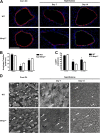Matrix metalloproteinase-7 coordinates airway epithelial injury response and differentiation of ciliated cells
- PMID: 23258229
- PMCID: PMC3604090
- DOI: 10.1165/rcmb.2012-0083OC
Matrix metalloproteinase-7 coordinates airway epithelial injury response and differentiation of ciliated cells
Abstract
Matrix metalloproteinase-7 (MMP7) expression is quickly up-regulated after injury, and functions to regulate wound repair and various mucosal immune processes. We evaluated the global transcriptional response of airway epithelial cells from wild-type and Mmp7-null mice cultured at an air-liquid interface. The analysis of differentially expressed genes between genotypes after injury revealed an enrichment of functional categories associated with inflammation, cilia, and differentiation. Because these analyses suggested that MMP7 regulated ciliated cell formation, we evaluated the recovery of the airway epithelium in wild-type and Mmp7-null mice in vivo after naphthalene injury, which revealed augmented ciliated cell formation in the absence of MMP7. Moreover, in vitro studies evaluating cell differentiation in air-liquid interface cultures also showed faster ciliated cell production under Mmp7-null conditions compared with wild-type conditions. These studies identified a new role for MMP7 in attenuating ciliated cell differentiation during wound repair.
Figures




Similar articles
-
MMP7 shedding of syndecan-1 facilitates re-epithelialization by affecting alpha(2)beta(1) integrin activation.PLoS One. 2009 Aug 10;4(8):e6565. doi: 10.1371/journal.pone.0006565. PLoS One. 2009. PMID: 19668337 Free PMC article.
-
Transdifferentiation of ciliated cells during repair of the respiratory epithelium.Am J Respir Cell Mol Biol. 2006 Feb;34(2):151-7. doi: 10.1165/rcmb.2005-0332OC. Epub 2005 Oct 20. Am J Respir Cell Mol Biol. 2006. PMID: 16239640 Free PMC article.
-
Human airway surface epithelial regeneration is delayed and abnormal in cystic fibrosis.J Pathol. 2007 Feb;211(3):340-50. doi: 10.1002/path.2118. J Pathol. 2007. PMID: 17186573
-
Matrix Metalloproteinase 7 Expression and Apical Epithelial Defects in Atp8b1 Mutant Mouse Model of Pulmonary Fibrosis.Biomolecules. 2022 Feb 9;12(2):283. doi: 10.3390/biom12020283. Biomolecules. 2022. PMID: 35204783 Free PMC article.
-
Tissue inhibitor of metalloproteinase-1 moderates airway re-epithelialization by regulating matrilysin activity.Am J Pathol. 2008 May;172(5):1256-70. doi: 10.2353/ajpath.2008.070891. Epub 2008 Apr 1. Am J Pathol. 2008. PMID: 18385523 Free PMC article.
Cited by
-
Expression of cilium-associated genes defines novel molecular subtypes of idiopathic pulmonary fibrosis.Thorax. 2013 Dec;68(12):1114-21. doi: 10.1136/thoraxjnl-2012-202943. Epub 2013 Jun 19. Thorax. 2013. PMID: 23783374 Free PMC article.
-
SOX2 and SOX21 in Lung Epithelial Differentiation and Repair.Int J Mol Sci. 2022 Oct 27;23(21):13064. doi: 10.3390/ijms232113064. Int J Mol Sci. 2022. PMID: 36361852 Free PMC article. Review.
-
Aberrant Multiciliogenesis in Pulmonary Fibrosis: Bystander or Driver of Disease Progression?Am J Respir Cell Mol Biol. 2022 Aug;67(2):142-144. doi: 10.1165/rcmb.2022-0201ED. Am J Respir Cell Mol Biol. 2022. PMID: 35612966 Free PMC article. No abstract available.
-
Sinomenine Relieves Airway Remodeling By Inhibiting Epithelial-Mesenchymal Transition Through Downregulating TGF-β1 and Smad3 Expression In Vitro and In Vivo.Front Immunol. 2021 Nov 5;12:736479. doi: 10.3389/fimmu.2021.736479. eCollection 2021. Front Immunol. 2021. PMID: 34804018 Free PMC article.
-
Shedding of Syndecan-1/CXCL1 Complexes by Matrix Metalloproteinase 7 Functions as an Epithelial Checkpoint of Neutrophil Activation.Am J Respir Cell Mol Biol. 2016 Aug;55(2):243-51. doi: 10.1165/rcmb.2015-0193OC. Am J Respir Cell Mol Biol. 2016. PMID: 26934670 Free PMC article.
References
-
- Opitz B, van Laak V, Eitel J, Suttorp N. Innate immune recognition in infectious and noninfectious diseases of the lung. Am J Respir Crit Care Med 2010;181:1294–1309 - PubMed
-
- Parks WC, Wilson CL, Lopez-Boado YS. Matrix metalloproteinases as modulators of inflammation and innate immunity. Nat Rev Immunol 2004;4:617–629 - PubMed
Publication types
MeSH terms
Substances
Grants and funding
LinkOut - more resources
Full Text Sources
Other Literature Sources
Molecular Biology Databases

